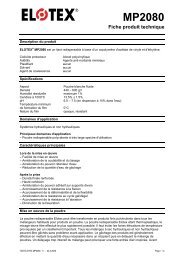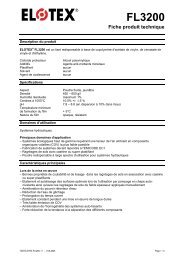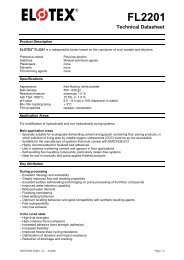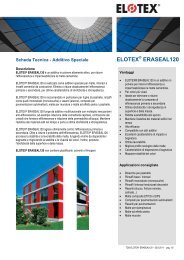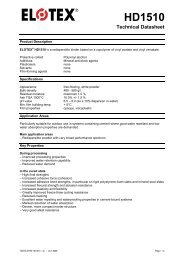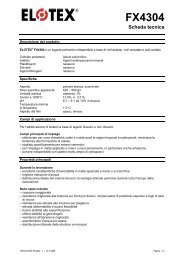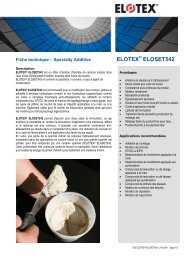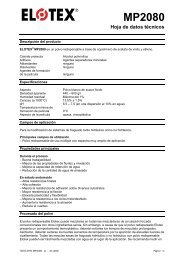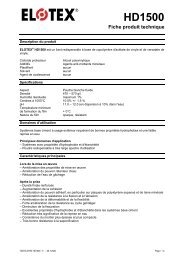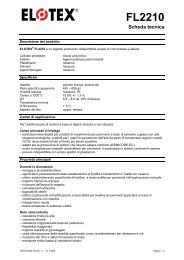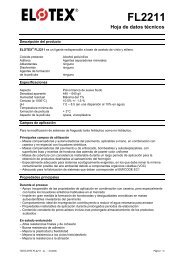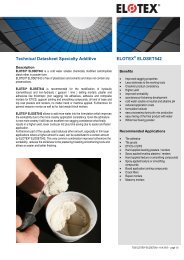new Approaches to Increase Water resistance of ... - Elotex AG
new Approaches to Increase Water resistance of ... - Elotex AG
new Approaches to Increase Water resistance of ... - Elotex AG
Create successful ePaper yourself
Turn your PDF publications into a flip-book with our unique Google optimized e-Paper software.
44<br />
AbstrAct<br />
dr. thomas Aberle studied chemistry at university <strong>of</strong> Freiburg,<br />
Germany, where he obtained his Phd in 1996. He then worked<br />
as scientific assistant there. In 2000 he joined <strong>Elotex</strong> <strong>AG</strong> in<br />
switzerland as leader <strong>of</strong> the Analytical Lab. since 2005 he is<br />
Head <strong>of</strong> the Material science Group, in 2005 he also became<br />
project leader for <strong>new</strong> product developments.<br />
t. Aberle, P. Emmenegger, F. Vallée, L. Herschke | <strong>Elotex</strong> <strong>AG</strong> | sempach-station, switzerland<br />
<strong>new</strong> <strong>Approaches</strong> <strong>to</strong> <strong>Increase</strong><br />
<strong>Water</strong> <strong>resistance</strong> <strong>of</strong> Gypsum based<br />
building Materials<br />
Gypsum is a major binder in a variety <strong>of</strong> dry mortar formulations such as<br />
gypsum lime plasters, finish plasters, gypsum board jointing compounds<br />
or anhydride screeds.<br />
Gypsum <strong>of</strong>fers a number <strong>of</strong> advantages for the use as a building material.<br />
It is largely available in most countries. Application and workability<br />
properties are excellent. Gypsum based materials have nearly no shrinkage<br />
problems and provide high fire <strong>resistance</strong>. In addition, carbon food<br />
print <strong>of</strong> gypsum is significant lower compared <strong>to</strong> cement.<br />
The main disadvantage <strong>of</strong> gypsum, especially versus cement, is the poor<br />
water <strong>resistance</strong>. There are only limited possibilities <strong>to</strong> increase water <strong>resistance</strong><br />
<strong>of</strong> gypsum building products, because the common hydrophobizing<br />
agents which are used for cementitious systems are not working<br />
in gypsum based materials.<br />
The present paper discusses existing and <strong>new</strong> approaches <strong>to</strong> increase<br />
water <strong>resistance</strong> <strong>of</strong> gypsum based dry mortars.<br />
Key words: gypsum based dry mortars, increased water <strong>resistance</strong>, hydrophobizing<br />
powder additives<br />
1. IntroductIon<br />
Gypsum is a naturally occurring mineral. In chemical<br />
terms, gypsum is calcium sulfate dihydrate (Ca-<br />
SO 4 x 2 H 2O). When calcium sulfate dihydrate is heated<br />
sufficiently crystal water is driven <strong>of</strong>f. Depending<br />
on the temperature, either calcium sulfate hemihydrate<br />
(CaSO 4 x 1/2 H 2O at about 140°C) or calcium<br />
sulfate anhydrite (CaSO 4 at about 600°C) is formed.<br />
This process is called calcination <strong>of</strong> gypsum.<br />
When mixed with water calcined gypsum reverts <strong>to</strong><br />
the original calcium sulphate dihydrate – the set<br />
and hardened gypsum product. The process <strong>of</strong> hydration<br />
and de-hydration and its natural occurrence<br />
makes gypsum <strong>to</strong> a sustainable resource, which in<br />
principal can be infinitely recycled.<br />
Gypsum and anhydride deposits are found in many<br />
countries. The best known deposits <strong>of</strong> natural gypsum<br />
are those <strong>of</strong> the Paris Basin and the areas<br />
around the Mediterranean. Beside natural occurring<br />
gypsum, this material is also produced as a by-product<br />
in industrial processes. So-called flue-gas gypsum<br />
(FGD gypsum) is obtained from the desulfurization<br />
<strong>of</strong> combustion gases <strong>of</strong> fossil fuels such as oil<br />
or bituminous coal. Gypsum, in particular in the dehydrated<br />
form <strong>of</strong> calcium sulfate α- and β-hemihydrate<br />
is a very common building raw material.<br />
Both, natural gypsum and flue-gas gypsum are used<br />
<strong>to</strong> produce hemihydrate. The relatively low calcination<br />
temperature <strong>of</strong> about 140°C and the fact that<br />
gypsum releases no crystalline CO 2 results in a significantly<br />
lower carbon food print compared <strong>to</strong> cement.<br />
The lower weight compared <strong>to</strong> cement, a high<br />
fire <strong>resistance</strong> and low shrinkage are further advan
tages <strong>of</strong> gypsum based products. Calcium sulfates<br />
are used in a variety <strong>of</strong> building formulations such<br />
as gypsum lime plasters, finish plasters, gypsum<br />
board jointing compounds or anhydride screeds.<br />
The high water sensitivity <strong>of</strong> gypsum based products,<br />
however, limits their use <strong>to</strong> dry indoor applications.<br />
For interior applications, where a certain level<br />
<strong>of</strong> water <strong>resistance</strong> is required, such as in<br />
bathrooms, kitchens, staircases, s<strong>to</strong>rage rooms, cellars,<br />
garages, warehouses or seashore areas, the<br />
gypsum formulations have <strong>to</strong> be hydrophobized in<br />
order <strong>to</strong> achieve sufficient water <strong>resistance</strong>.<br />
Cured gypsum mortar consists <strong>of</strong> 50-60 vol% pores,<br />
most <strong>of</strong> them having a pore size between 0.3 – 1.0<br />
µm. This means that pores in a gypsum matrix have<br />
diameters, where capillary suction forces are active<br />
(Jakobsmeier, 2000). The high content <strong>of</strong> these<br />
macropores, the water solubility <strong>of</strong> gypsum and the<br />
relative large gypsum crystals are fac<strong>to</strong>rs, which<br />
highly contribute <strong>to</strong> the water sensitivity <strong>of</strong> such<br />
building materials. When exposed <strong>to</strong> water or high<br />
humidity gypsum based building materials can be<br />
severely damaged. Figure 2 shows a plaster wall damaged<br />
by the influence <strong>of</strong> water.<br />
Lots <strong>of</strong> efforts have been made in order <strong>to</strong> increase<br />
the water <strong>resistance</strong> <strong>of</strong> gypsum. Nevertheless, there<br />
are still only a few hydrophobizing additives on the<br />
market which are suited <strong>to</strong> increase the water <strong>resistance</strong><br />
<strong>of</strong> gypsum based building materials. Many<br />
<strong>of</strong> those additives are in liquid form and therefore<br />
excluded for the production <strong>of</strong> dry mortars.<br />
dr. Laurent Herschke studied Physical chemistry at université claude bernard, Lyon<br />
and at université Louis Pasteur, strasbourg, France. He obtained his Phd at Max<br />
Planck Institute for Polymer research (MPIP), Mainz, Germany. during and after his<br />
studies he worked for rhodia, Henkel and rohm & Haas and for a longer period at<br />
Air Products & chemicals in utrecht. He joined <strong>Elotex</strong> (stationed in Hoechst,<br />
Germany) in 2008 and works there as <strong>new</strong> business development Manager.<br />
Thus, there is still a need for hydrophobizing powder<br />
additives enabling the formulation <strong>of</strong> gypsum<br />
based dry mortars. The present paper discusses the<br />
most common used hydrophobizing additives for<br />
gypsum based dry mortar formulations and presents<br />
latest developments in this field <strong>of</strong> research.<br />
Figure 1: scanning<br />
electron microscopy<br />
(sEM) image <strong>of</strong> a gypsum<br />
based joint filler.<br />
relatively large aggregates<br />
<strong>of</strong> gypsum crystals<br />
and pores in between<br />
dominate the structure.<br />
Figure 2: <strong>Water</strong> damaged<br />
plaster wall.<br />
Drymix Mortar Yearbook 2010<br />
45
46<br />
2. MEtHods And MAtErIALs<br />
2.1 Following methods were used <strong>to</strong> evaluate<br />
water <strong>resistance</strong> in this study:<br />
2.1.1 Determination <strong>of</strong> the water absorption <strong>of</strong><br />
gypsum mortars on gypsum plaster-boards,<br />
following EN 520 – water uptake after 2 hours.<br />
The dry gypsum formulation is added <strong>to</strong> the required<br />
amount <strong>of</strong> mixing water while stirring slowly.<br />
This mixture is further stirred for one minute with<br />
a propeller stirrer with a speed <strong>of</strong> 950 rpm. After a<br />
maturing time <strong>of</strong> 3 minutes the mortar is stirred<br />
again by hand for 15 seconds and then applied with<br />
1.5 mm thickness on<strong>to</strong> a 12 mm thick gypsum plaster<br />
board and s<strong>to</strong>red at 23°C/50% relative humidity<br />
for 7 days. After 6 days polypropylene rings with an<br />
inner diameter <strong>of</strong> 100 mm and a height <strong>of</strong> 100 mm<br />
are fixed on <strong>to</strong>p <strong>of</strong> the mortar surface with the aid<br />
<strong>of</strong> silicone paste. The next day the board is weighed,<br />
and subsequently being filled with 250 g <strong>of</strong> water<br />
and left for 2 hours. After removal <strong>of</strong> the remaining<br />
water the wet surface is wiped <strong>of</strong>f and weighed<br />
again. The water absorption is being calculated by<br />
the difference in the weight values measured before<br />
and after the water treatment, which is indicated<br />
in kg/m 2 .<br />
2.1.2 Determination <strong>of</strong> the surface hydrophobicity<br />
– water drop test<br />
The gypsum formulation is applied the same way as<br />
for the water absorption test on<strong>to</strong> the gypsum plaster-boards<br />
and s<strong>to</strong>red at 23°C/50% relative humidity<br />
for 7 days. 5 drops (circa 0.2 ml) <strong>of</strong> water are applied<br />
on<strong>to</strong> the mortar surface and the time for<br />
complete absorption is measured.<br />
2.2 Materials<br />
2.2.1 Gypsum based dry mortar formulations<br />
A gypsum plaster formulation and a jointing compound<br />
for plasterboards were tested according <strong>to</strong><br />
their water <strong>resistance</strong>. The compositions <strong>of</strong> the investigated<br />
dry mortar formulations are given in Table<br />
1.<br />
Figure 3: setup <strong>to</strong><br />
measure water uptake<br />
(cobb-test).
Table 1: Composition <strong>of</strong> the tested gypsum formulations.<br />
Interior gypsum plaster<br />
Jointing compound<br />
Hand or machine applied<br />
for plasterboards<br />
component<br />
[weight %]<br />
[weight %]<br />
α- and or �-Hemihydrate 20 - 40 40 - 60<br />
Hydrated Lime** 0.5 - 3 0 - 3<br />
Calcium Carbonate 55 - 75 30 - 40<br />
China Clay 0 5 - 6<br />
Mica Filler 0 8 - 10<br />
Light weight Filler 0 - 3 0<br />
Air entraining Agent 0.01 - 0.03 0<br />
Set Retarder 0.05 - 0.07 0.05 - 0.15<br />
Cellulose Ether 0.1 - 0.3 0.2 - 0.4<br />
Starch Ether 0.02 - 0.04 0.01 - 0.03<br />
Redispersible Polymer Powder 0 2 - 3<br />
Mixing <strong>Water</strong> * 40 - 45 40 - 45<br />
* Based on <strong>to</strong>tal dry mix formulation<br />
** A small portion <strong>of</strong> hydrated lime is present in both formulations in order <strong>to</strong> enable fast hydrolysis <strong>of</strong><br />
silanes (one class <strong>of</strong> the tested hydrophobizing additives). At neutral pH, silanes are not effective<br />
2.2.2 Hydrophobizing additives<br />
The following hydrophobizing additives were included<br />
in this study<br />
– Fatty acids and their salts (liquid and powder<br />
form)<br />
– Wax emulsions (liquid state)<br />
– Additives based on silane or siloxane<br />
technology<br />
• Standard alkyl oxy silanes as used for<br />
cementitious systems (powder form)<br />
• H-terminated silanes and H-terminated<br />
polysiloxanes (liquid state)<br />
• Alkyl silicon resins (powder from)<br />
• New development additives based on<br />
special alkyl oxy silane chemistry, e.g.<br />
<strong>Elotex</strong> BN Seal 712 (powder form)<br />
3. rEsuLts<br />
The effect <strong>of</strong> hydrophobizing additives which belong<br />
<strong>to</strong> the above mentioned chemical classes was<br />
measured for a gypsum plaster and for an gypsum<br />
based jointing compound. Resulting water uptake<br />
according <strong>to</strong> the Cobb test and surface hydrophobicity<br />
(water drop test) are shown in Figures 4 – 7.<br />
Beside the resulting water <strong>resistance</strong>, also fresh<br />
mortar properties were evaluated. The results are<br />
summarized in Table 2.<br />
Drymix Mortar Yearbook 2010<br />
47
48<br />
3.1 Effect <strong>of</strong> hydrophobizing additives in<br />
gypsum based jointing compound<br />
Fig. 4 and Fig. 5 show the water uptake <strong>of</strong> a gypsum<br />
based jointing compound without and with hydrophobizing<br />
additives.<br />
Figure 4: Averaged water uptake reduction <strong>of</strong> gypsum based jointing compound with<br />
different hydrophobizing additives at the given typical concentration in comparison <strong>to</strong><br />
the non hydrophobized gypsum based jointing compound according <strong>to</strong> formulation<br />
given in table 1. typical concentration range <strong>of</strong> hydrophobizing additive is given in<br />
weight percent on <strong>to</strong>tal dry mix<br />
Significant reduced water uptake <strong>of</strong> the jointing<br />
compound is achieved with hydrophobizing additives<br />
based on H-terminated silane, alkylsilicon resin<br />
on inorganic carrier and the <strong>new</strong>ly developed<br />
dry powder additive based on a <strong>new</strong> encapsulated<br />
silane technology.<br />
Fatty acid based additives, paraffin / montan wax<br />
emulsions and standard alkyl alkoxy silane used for<br />
cementitious systems (e.g. <strong>Elotex</strong> Seal 80) cannot<br />
decrease water uptake <strong>of</strong> the tested jointing compound,<br />
even when used at relatively high dosages.<br />
Very good surface hydrophobicity (water drop remains<br />
> 300 minutes on surface) is achieved with<br />
H-terminated silanes, alkyl silicon resins and with<br />
the dry powder additive based on a <strong>new</strong> encapsulated<br />
silane technology.<br />
Figure 5: Averaged surface hydrophobicity (water drop test) <strong>of</strong> gypsum based jointing<br />
compound with different hydrophobizing additives at the given typical concentration in<br />
comparison <strong>to</strong> the non hydrophobized gypsum based jointing compound according <strong>to</strong><br />
formulation given in table 1. typical concentration range <strong>of</strong> hydrophobizing additive is<br />
given in weight percent on <strong>to</strong>tal dry mix.
3.2 Effect <strong>of</strong> hydrophobizing additives in<br />
indoor gypsum plaster<br />
Fig. 6 and Fig. 7 show the water uptake <strong>of</strong> a indoor<br />
gypsum plaster without and with hydrophobizing<br />
additives.<br />
As for the jointing compounds, significant reduced<br />
water uptake is achieved with additives based on<br />
H-terminated silane, alkylsilicon resin on inorganic<br />
carrier and the <strong>new</strong>ly developed dry powder additive<br />
based on a <strong>new</strong> encapsulated silane technology.<br />
In addition, also additives based on fatty acids can<br />
decrease water uptake <strong>of</strong> the tested gypsum plaster<br />
formulation. Powder based on standard alkyl<br />
oxy silane technology (as used for cementitious systems)<br />
cannot reduce water uptake <strong>of</strong> the gypsum<br />
plaster.<br />
A very good surface hydrophobicity, marked by an<br />
adsorption time <strong>of</strong> a water drop on the surface larger<br />
than 450 minutes is achieved with alkyl silicon<br />
resins and with the dry powder additive based on a<br />
<strong>new</strong> encapsulated silane technology.<br />
Acceptable surface hydrophobicity, marked by an<br />
adsorption time <strong>of</strong> water drop on the surface no<br />
longer than 300 minutes is reached with additives<br />
based on fatty acid chemistry, H-terminated silanes<br />
and paraffin / montan wax emulsions.<br />
3.3 Fresh Mortar Properties<br />
Beside increased water <strong>resistance</strong> <strong>of</strong> the cured gypsum<br />
material, also fresh mortar properties, such as<br />
wetting, mixing and workability, are <strong>of</strong> great importance.<br />
Table 2 summarizes fresh mortar properties<br />
and resulting water <strong>resistance</strong> <strong>of</strong> the investigated<br />
hydrophobizing additives in dependence <strong>of</strong><br />
their composition, appearance and concentration.<br />
Figure 6: Averaged water uptake <strong>of</strong> indoor gypsum plaster with different hydrophobizing<br />
additives at the given typical concentration in comparison <strong>to</strong> the non hydrophobized<br />
gypsum plaster according <strong>to</strong> formulation given in table 1. typical concentration range <strong>of</strong><br />
hydrophobizing additive is given in weight percent on <strong>to</strong>tal dry mix.<br />
Figure 7: Averaged surface hydrophobicity (water drop test) <strong>of</strong> indoor gypsum<br />
plaster with different hydrophobizing additives at the given typical concentration in<br />
comparison <strong>to</strong> the non hydrophobized gypsum plaster according <strong>to</strong> formulation<br />
given in table 1. typical concentration range <strong>of</strong> hydrophobizing additive is given in<br />
weight on <strong>to</strong>tal dry mix.<br />
Drymix Mortar Yearbook 2010<br />
49
Table 2<br />
Hydrophobizing additive – dosage [wt % on<br />
Fresh mortar properties cured mortar<br />
chemical basis<br />
dry formulation] Appearance Wetting Mixing Workability <strong>Water</strong> <strong>resistance</strong><br />
Blank - - + ++ ++ -<br />
H-terminated silanes<br />
Alkyl silicon resin on<br />
0.1 – 0.5 Liquid form - - - ++<br />
inorganic carrier 0.5 – 2 Powder form - - + ++<br />
Wax emulsion 2 – 5 Liquid form<br />
Liquid /<br />
- - 0 -<br />
Fatty acids or salts there<strong>of</strong> 0.5 - 1 Powder form - - + - / + **<br />
<strong>Elotex</strong> Seal 80 0.3 – 0.5 Powder form + ++ ++ -<br />
<strong>Elotex</strong> BN Seal 712 0.2 – 0.5 Powder form + ++ ++ ++<br />
Scale: Poor (-), neutral (0), good (+), very good (++)<br />
** <strong>Water</strong> <strong>resistance</strong> fatty acids: poor results in jointing compound; acceptable results in plaster.<br />
table 2: overview <strong>of</strong> the<br />
resulting fresh mortar<br />
properties and water<br />
<strong>resistance</strong> <strong>of</strong> cured<br />
gypsum mortars using<br />
the investigated<br />
hydrophobizing additives<br />
in comparison <strong>to</strong> <strong>Elotex</strong><br />
seal 80. this is an<br />
hydrophobizing additive<br />
for cement based<br />
products based on an<br />
encapsulated standard<br />
alkyl oxy silane.<br />
50<br />
4. dIscussIon<br />
Hydrophobizing powder additives for cement based<br />
dry mortars are well known. Many <strong>of</strong> them are<br />
based on fatty acids or alkyl oxy silane types (e.g.<br />
<strong>Elotex</strong> Seal 80).<br />
To increase water <strong>resistance</strong> <strong>of</strong> gypsum based dry<br />
mortars, however, remains still challenging.<br />
detailed discussion <strong>of</strong> the tested additives<br />
– Fatty acids and their salts<br />
Fatty acids and their salts are common additives <strong>to</strong><br />
hydrophobise cementitious systems. In our gypsum<br />
test formulations, however, we could measure no<br />
(in case <strong>of</strong> jointing compound), respectively limited<br />
increase <strong>of</strong> water <strong>resistance</strong> (in case <strong>of</strong> gypsum<br />
plaster). In order <strong>to</strong> obtain a significant increase in<br />
water <strong>resistance</strong>, relatively high dosages are required,<br />
which results in poor fresh mortar properties.<br />
– Wax emulsions<br />
Wax emulsions, such as paraffin or montan wax<br />
emulsions are also used <strong>to</strong> increase water <strong>resistance</strong><br />
<strong>of</strong> gypsum. Such additives are used and known for<br />
the plasterboard production (US patent,<br />
US005437722A). In gypsum based dry mortars, such<br />
as joint fillers or renders we could measure nearly<br />
no effect with this type <strong>of</strong> additives even when used<br />
in dosages up <strong>to</strong> 5 wt% based on the dry formulation.<br />
– Silane or siloxane technology<br />
Various technologies are described in literature and<br />
patents which use silane or siloxane based compounds<br />
as hydrophobizing components for gypsum<br />
based products (e.g. US2002/0040666 A1 or<br />
WO 9950200).<br />
Common <strong>to</strong> all these type <strong>of</strong> additives is the requirement<br />
<strong>of</strong> a catalyst <strong>to</strong> enable fast hydrolysis <strong>of</strong><br />
the silane. In most cases, a high pH acts as the catalyst.<br />
For cementitious systems this is au<strong>to</strong>matically<br />
given, whereas <strong>to</strong> the gypsum formulations a small<br />
portion <strong>of</strong> e.g. lime has <strong>to</strong> be added (see Table 1).
Silane and siloxane technology can be divided in<strong>to</strong><br />
different sub-classes.<br />
a.) Standard alkyl alkoxy silanes<br />
For cementitious dry mortars modern hydrophobicity<br />
additives are available (such as <strong>Elotex</strong> Seal 80<br />
with no delay in wetting upon mixing).<br />
However, this type <strong>of</strong> silane cannot increase water<br />
<strong>resistance</strong> <strong>of</strong> gypsum based systems. In best case, a<br />
slight improve in surface hydrophobicity can be observed.<br />
b.) H-terminated silanes and polysiloxanes<br />
So called H-terminated silanes or H-terminated polysiloxanes<br />
are commonly used <strong>to</strong> increase water<br />
<strong>resistance</strong> <strong>of</strong> gypsum based building products, especially<br />
<strong>of</strong> plasterboards. An alkaline pH is required<br />
in order <strong>to</strong> have a sufficiently rapid hydrolysis and<br />
condensation reaction taking place during the casting<br />
and drying steps <strong>of</strong> plasterboard manufacturing<br />
process. The hydrolysis reaction releases hydrogen.<br />
Upon use in gypsum based dry mortars, this<br />
induces a poor surface quality (e.g. surface blow up)<br />
as well as a poor workability, already noticeable at<br />
dosages as low as 0.1 wt%. This severely limits the<br />
use <strong>of</strong> H-terminated silanes and H-terminated polysiloxanes<br />
in dry mortars.<br />
On the other hand, the achieved increase in water<br />
<strong>resistance</strong> <strong>of</strong> this type <strong>of</strong> silanes is excellent.<br />
Figure 8: chemical structure <strong>of</strong> H-terminated silane. n = 1-<br />
4: oligomeric H-terminated siloxane; n > 4: polymeric Hterminated<br />
siloxane<br />
c.) Alkyl silicon resins<br />
Alkyl silicon resins with alkoxy functionalities are also<br />
used <strong>to</strong> increase water <strong>resistance</strong> <strong>of</strong> gypsum based<br />
building products. In alkaline environment these<br />
silicon resins can hydrolyse and further<br />
condensate forming a 3-dimensional network<br />
which permanently bonds <strong>to</strong> the gypsum crystals.<br />
In order <strong>to</strong> make them available in powder form, silicon<br />
resins can be adsorbed on an inorganic carrier.<br />
Main disadvantages <strong>of</strong> such powders are their hydrophobic<br />
surface which results in strong delayed<br />
wetting and their poor long-term s<strong>to</strong>rage stability,<br />
which <strong>of</strong>ten results in a loss <strong>of</strong> performance over<br />
extended period <strong>of</strong> time.<br />
d.) New developments based on special encapsulated<br />
alkyl oxy silane<br />
The state-<strong>of</strong>-the-art hydrophobizing additives<br />
which allow <strong>to</strong> decrease the water <strong>resistance</strong> <strong>of</strong><br />
gypsum based materials are either only available in<br />
liquid form or cause delayed wetting. Furthermore,<br />
the s<strong>to</strong>rage stability <strong>of</strong> the dry mix is <strong>of</strong>ten reduced,<br />
meaning that the hydrophobic effect decreases<br />
when the dry mix is s<strong>to</strong>red for a few months.<br />
Therefore, there is still a need for dry powder additives,<br />
which deliver excellent hydrophobicity <strong>of</strong><br />
gypsum based materials. Furthermore, the additive<br />
itself, as well as the dry mortar containing the additive<br />
must have a sufficient s<strong>to</strong>rage stability and provide<br />
a good wettability upon mixing with water.<br />
A <strong>new</strong> developed hydrophobizing additive in powder<br />
form based on a special, encapsulated alkyloxysilane<br />
technology, <strong>Elotex</strong> BN Seal 712 fulfils these<br />
requirements. Despite the high reactivity <strong>of</strong> the silane<br />
molecules, the shelf life <strong>of</strong> the dry powder as<br />
well as <strong>of</strong> the dry mortar containing the additive is<br />
excellent.<br />
Drymix Mortar Yearbook 2010<br />
51
Figure 9: <strong>Water</strong> uptake <strong>of</strong><br />
gypsum based joint filler<br />
versus dosage <strong>of</strong> <strong>Elotex</strong><br />
bn seal 712<br />
52<br />
Figure 11: test for bulk<br />
hydrophobicity.<br />
Figure 9 shows a linear dependence <strong>of</strong> the water<br />
uptake with the <strong>Elotex</strong> BN Seal 712 dosage until a<br />
plateau is achieved at around 160 g/m 2 (Cobb test),<br />
a value well below the limit <strong>of</strong> 180 g/m 2 set by the<br />
European standard EN 520. Hence, the required level<br />
<strong>of</strong> water <strong>resistance</strong> can easily be adjusted via<br />
the dosage <strong>of</strong> <strong>Elotex</strong> BN Seal 712.<br />
Figure 10 shows the gypsum plaster formulation as<br />
given in Table 1 with and without the modification<br />
<strong>of</strong> <strong>Elotex</strong> BN Seal 7122. Clear improvements <strong>of</strong> water<br />
<strong>resistance</strong> with this product can be seen on the<br />
untreated surface, as well as on the scratched/sanded<br />
surface.<br />
a.) colored water added on fractured surface <strong>of</strong> a<br />
commercial interior gypsum-lime plaster<br />
formulation without hydrophobizing additive<br />
(reference).<br />
Figure 10: Improvement <strong>of</strong> the water <strong>resistance</strong> <strong>of</strong> the<br />
gypsum-lime plaster formulation by addition <strong>of</strong> 0.5wt%<br />
<strong>Elotex</strong> bn seal 712 (right) in comparison <strong>to</strong> the non<br />
modified gypsum-lime plaster formulation (left) by water<br />
drop test. comparison <strong>of</strong> untreated surface (upper<br />
pictures) and scratched/sanded surface (lower pictures).<br />
The capability <strong>of</strong> <strong>Elotex</strong> BN Seal 712 <strong>to</strong> protect beside<br />
the surface also the bulk <strong>of</strong> gypsum based building<br />
mortars and products against water penetration<br />
is demonstrated in Figure 11.<br />
b.) colored water added on fractured surface <strong>of</strong> a<br />
commercial interior gypsum-lime plaster formulation<br />
with 0.5wt% <strong>Elotex</strong> bn seal 712 hydrophobizing<br />
additive.
<strong>Water</strong> is adsorbed immediately on the fractured<br />
surface <strong>of</strong> a commercial interior gypsum-lime plaster<br />
formulation without hydrophobizing additive<br />
(reference). When modified with 0.5wt% <strong>Elotex</strong> BN<br />
Seal 712 the fracture surface shows a strong pearling<br />
effect. <strong>Water</strong> does not penetrate in<strong>to</strong> the gypsum<br />
matrix, hence protecting the gypsum-lime<br />
plaster against the detrimental effects <strong>of</strong> frequent<br />
water exposure.<br />
5. concLusIon And outLooK<br />
Main disadvantage <strong>of</strong> gypsum based building materials<br />
is their poor water <strong>resistance</strong>. When modified<br />
with hydrophobizing additives, the water <strong>resistance</strong><br />
and durability <strong>of</strong> gypsum based building products<br />
is greatly improved. This opens the possibility <strong>to</strong> widen<br />
the use <strong>of</strong> gypsum mortars in wet humid indoor<br />
areas, such as kitchen, bathroom, staircase, s<strong>to</strong>rage<br />
rooms, cellars, garages, warehouse or seashore<br />
areas as alternative solution <strong>to</strong> <strong>to</strong>days cementitious<br />
products. Furthermore, hydrophobic modified gypsum<br />
based dry mortars open the possibility <strong>to</strong> be<br />
used as final coatings with decorative function<br />
without being over-painted (all-in-one building system).<br />
Based on our study, most suited hydrophobizing<br />
additives for dry gypsum mortars are based on silane<br />
or siloxane technology. The <strong>new</strong> developed hydrophobizing<br />
additive in powder form, <strong>Elotex</strong> BN<br />
Seal 712, results at low dosage in very low water uptake<br />
and eliminates the drawbacks <strong>of</strong> <strong>to</strong>day’s gypsum<br />
hydrophobizing additives, such as their poor<br />
workability, poor mixing properties or loss <strong>of</strong> performance<br />
upon ageing.<br />
In order <strong>to</strong> have sufficient water <strong>resistance</strong> a catalyst<br />
is required <strong>to</strong> speed up the hydrolysis reaction<br />
<strong>of</strong> silane-based hydrophobizing additives. A certain<br />
amount <strong>of</strong> lime present in the dry gypsum formulation<br />
or the addition <strong>of</strong> aliquot <strong>of</strong> cement can act as<br />
such a catalyst. Consequently, dry gypsum based<br />
mortar formulations when mixed with water are<br />
highly alkaline. The high pH is not always acceptable.<br />
Therefore additional efforts will be necessary <strong>to</strong><br />
develop an hydrophobizing additive which also<br />
works at neutral pH. First promising lab results based<br />
on a complete <strong>new</strong> technology show that it is<br />
also possible <strong>to</strong> achieve very low water uptake <strong>of</strong><br />
gypsum based building materials at neutral pH with<br />
a dry powder hydrophobizing additive.<br />
AcKnoWLEdGEMEnts<br />
The authors would like <strong>to</strong> thank Dr. Roger Zurbriggen,<br />
Mr. Adrian Keller and Mr. Joerg Lang for their<br />
inputs and help. Special thanks <strong>to</strong> Mr. Joerg Lang for<br />
providing the various pictures used in this study.<br />
rEFErEncEs<br />
[1] Jakobsmeier, L. (2000): Reaktivität und Wechselwirkungen<br />
siliciumorganischer Verbindungen in<br />
einer CaSO 4 x 2 H 2O-Matrix. PhD Thesis; University<br />
<strong>of</strong> Erlangen-Nürnberg, Germany.<br />
[2] <strong>Water</strong>-resistant gypsum compositions and emulsions<br />
for making same (1995); US Patent Number<br />
US005437722A.<br />
[3] Hydrophobiczing agents for hydrophobicizing<br />
gypsum-plaster bound construction materials<br />
(2002); US Patent Number 2002/0040666 A1<br />
[4] Method for damp-pro<strong>of</strong>ing plaster using at least<br />
an alkylhydrogenopolysiloxane and at least a hydrocolloid<br />
(1999); Patent Number WO 9950200<br />
Figure 12: <strong>Water</strong> drop on<br />
surface <strong>of</strong> gypsum based<br />
joint filler modified with<br />
<strong>Elotex</strong> experimental<br />
hydrophobizing additive<br />
for neutral pH.<br />
Drymix Mortar Yearbook 2010<br />
53
SpeCiAlty AdditiveS<br />
With <strong>Elotex</strong> Specialty Additives, a <strong>new</strong> era <strong>of</strong> dry mortar technology /<br />
performance is achieved. You can now formulate dry mortars with<br />
strong water <strong>resistance</strong>, or with reduced primary and secondary<br />
efflorescence. Furthermore you can easily formulate high quality<br />
leveling compounds, increase the structure viscosity properties or<br />
formulate dry mortars with optimum corrosion protection.<br />
www.akzonobel.com/elotex<br />
AkzoNobel Functional Chemicals<br />
<strong>Elotex</strong> <strong>AG</strong><br />
Industriestrasse 17a | 6203 Sempach Station | Switzerland<br />
T +41 41 469 69 69 | F +41 41 469 69 00<br />
contact.elotex@elotex.com



